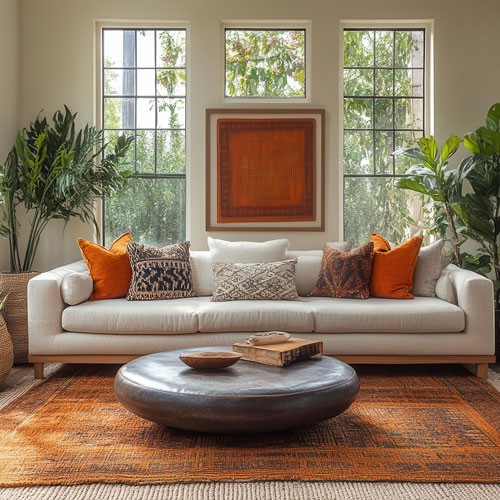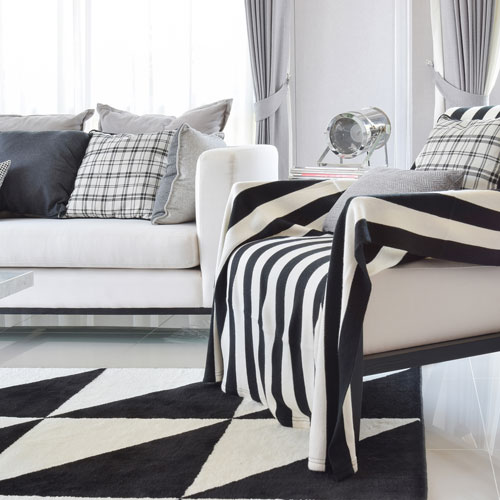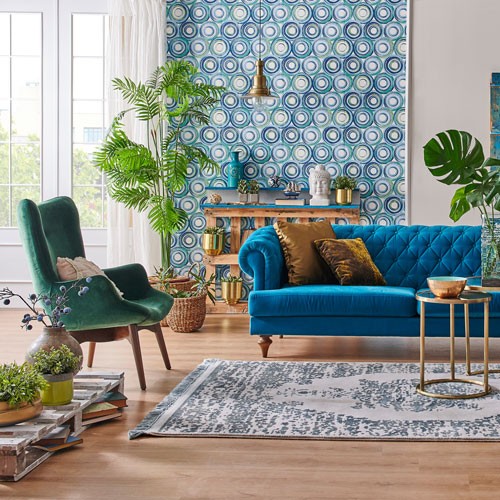Mixing Patterns: How to Pair Area Rugs with Other Patterns
Mixing patterns adds depth and dimension to your home, while allowing you to express your personal style. Area rugs provide the perfect foundation for pattern play, allowing you to easily experiment with different styles without committing to a long-term investment. But mixing patterns can overwhelm a space if not done correctly. So how do you choose complementary area rugs and other patterned elements for your home?
How Do You Match Patterns in Decorating?

Create balance and cohesion when matching patterns in decorating. Here are some key principles:
- Color Palette: Choose a limited color palette to unify your patterns.
- Pattern Scale: Vary pattern sizes for visual interest. A large-scale pattern can anchor the room while smaller patterns add detail.
- Pattern Type: Consider the types of patterns you’re combining. Geometric, floral, and abstract patterns can complement each other when balanced.
- Repetition: Repeat elements from one pattern in another for cohesion.
- Negative Space: Allow patterns to breathe by incorporating solid colors or plain surfaces.
How Many Patterns Can You Mix in a Room?

While it’s tempting to experiment with a multitude of patterns, beginners might find it easier to start with just two. As you gain confidence, you can gradually incorporate more. Typically, three or four patterns create a visually interesting space without overwhelming it.
Do Floral and Geometric Patterns Go Together?

Absolutely! Floral and geometric patterns can create a dynamic and visually interesting combination.
Here are some other classic combinations to consider:
- Stripes and Polka Dots: A playful and energetic combination.
- Damask and Chevron: A sophisticated blend of traditional and modern.
- Floral and Houndstooth: An unexpected pairing that can add interest.
- Geometric and Scallop: A modern and fresh combination.
How Do I Mix Patterns with a Patterned Rug?
A patterned rug serves as a versatile foundation for incorporating multiple patterns into a room. Here’s how to create a harmonious and stylish space:
- Define Your Style: Select a rug that reflects your personal aesthetic. A bold geometric rug can create a modern vibe, while a floral pattern offers a romantic feel.
- Consider Room Size and Layout: A large-scale pattern might overwhelm a small space, while a subtle pattern can get lost in a large room.
- Vary Pattern Scale: Mixing different pattern scales creates visual interest. Pair a large-scale rug with smaller patterns on furniture or accessories.
- Introduce Solid Colors: Balance a bold patterned rug with solid-colored furniture or accessories to prevent overwhelming your space.
How Do I Coordinate Two Rugs in One Room?
Harmoniously combining two rugs requires careful consideration of color, pattern, and size. Ensure rugs complement your room’s layout and style, creating a cohesive and visually appealing space.
How Do You Pair Rug Patterns?
Some seamless pairings include:
- Geometric Rug: Pair with striped or chevron patterns for a contemporary look.
- Floral Rug: Combine with damask or paisley patterns for a traditional or bohemian feel.
- Oriental Rug: Introduce a modern pattern like a geometric or abstract to create a fusion style.
Can You Use a Patterned Rug with Patterned Furniture?
Absolutely! You can definitely use a patterned rug with patterned furniture. The key is balance. A large-scale, bold pattern on the rug can complement a smaller, subtler pattern on furniture, or vice versa.
Mixing patterns can elevate your home decor, but it requires careful consideration. By understanding the principles of color, scale, and balance, you can confidently incorporate patterned area rugs into your space.
Ready to transform your space? Explore our stunning collection of area rugs at Floor Boys and let our experts help you find the perfect patterns to elevate your home decor. You can also visit any of our convenient locations in South Carolina.

